Kentucky Pesticide Safety Education Program

Questions?
Contact
Dr. Ric Bessin
Dept. of Entomology
University of Kentucky
859-257-7450
rbessin@email.uky.edu
Insects and Other Arthropods
Insects, spiders, scorpions, millipedes, centipedes, ticks, and mites are arthropods. They have hard external skeletons and segmented legs and bodies. Most insects have 3 main body regions and 3 pairs of legs; they are the only arthropods that can fly.
Insect Life Cycles and Growth
Insects go through a series of changes during their development from egg to adult in a process called metamorphosis. When the insect hatches from an egg, it is either a nymph (gradual metamorphosis) or a larva (complete metamorphosis). The immature stage must shed its external skeleton, a process called molting, in order to grow.
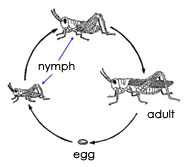
Grasshoppers undergo gradual metamorphosis, passing through three stages of development: egg, nymph, and adult. Nymphs resemble adults. They eat the same food and live in the same environment. The change in form from nymph to adult is gradual. Only the adult state has wings. Other examples are aphids, stink bugs, and leafhoppers.
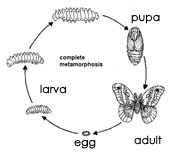 Insects with complete metamorphosis include butterflies and moths, beetles, flies, bees, and ants. There are four stages in complete metamorphosis – egg, larva, pupa, and adult. The larvae, are specialized for feeding and look very different from the adult. They have general names such as caterpillar, maggot, white grub, or wireworm. Larvae usually live in very different situations and often feed on different foods than adults.
Insects with complete metamorphosis include butterflies and moths, beetles, flies, bees, and ants. There are four stages in complete metamorphosis – egg, larva, pupa, and adult. The larvae, are specialized for feeding and look very different from the adult. They have general names such as caterpillar, maggot, white grub, or wireworm. Larvae usually live in very different situations and often feed on different foods than adults.
A variety of insects and mites can attack plants but most are not pests. Some are beneficial, providing natural control or pollination services. Others are scavengers on dead or dying plants so they recycle nutrients. Just because an insect is around damage does not mean it was the cause.
Mouthparts and Feeding - Ways Insects Can Damage Plants
Pest insects may be divided into major groups according to how they feed:
- piercing-sucking
- chewing
- rasping plant tissue
Piercing-Sucking
Sap feeders with piercing-sucking mouthparts can cause wilting, leaf curl, or stunted foliage. Chemicals injected by some species of leafhoppers can cause leaf burn. Stink bug feeding can cause distorted leaves or fruit. Several aphid and leafhopper species can carry virus diseases.
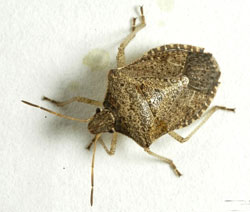
photo: Herb Pilcher, USDA Agricultural Research Service, Bugwood.org

photo: Jim Occi, BugPics, Bugwood.org
Chewing
Chewers include caterpillars and beetles. They feed on leaves, fruit, or grain. The amount of feeding a plant can tolerate without significant impact on growth or yield varies with a plant’s age, growth stage, or stress (drought, etc.).
Caterpillars
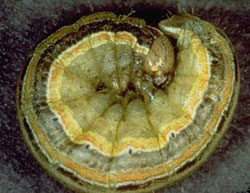
photo: Frank Peairs, Colorado State University, Bugwood.org
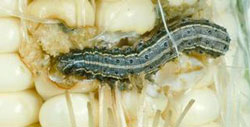
Phil Sloderbeck, Kansas State University, Bugwood.org
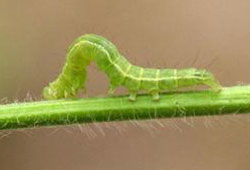
Daren Mueller, Iowa State University, Bugwood.org
The green cloverworm is one of the most common leaf feeding insects in Kentucky soybeans. However, it rarely reduces yield because of the soybean plant's ability to compensate for foliage losses.
The slender, light green caterpillars have three pairs of white stripes that run the length of the body. There are three pairs of legs near the head, three pairs of fleshy legs near the middle of the body, and a pair of fleshy legs at the tail end. Most soybean caterpillars have four pairs of legs near the middle of the body. GCW larvae wiggle violently when disturbed.
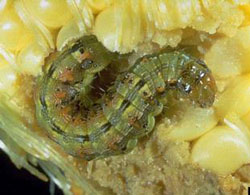
R. L. Croissant, Bugwood.org
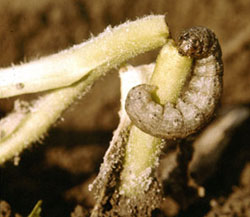
Clemson University - USDA Cooperative Extension Slide Series, Bugwood.org
Beetles
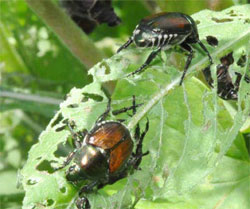
The Japanese beetle feeds on many plants, including corn and soybeans. These insects will congregate in corn fields during pollination. There is concern that silk feeding by this insect can interfere with pollination. Pollination can occur as long as there is at least one-half inch of silk present during pollen shed. Large numbers of adults also will feed on soybean leaves, especially in fields where smartweed is present.
The larval stage of the Japanese beetle is a white grub that feeds below ground on plant roots. Females usually lay their eggs in pastures and grassy areas but may deposit some in corn and soybean fields. The grubs do most of their feeding in late summer. There is rarely enough damage to the root systems of these crops to affect yield. The grubs feed little, if any, in the spring so there is no danger to crops planted the following year.
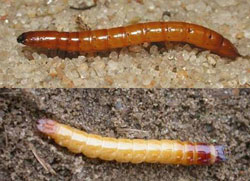
photo: Virginia Polytechnic Institute and State University
Rasping

photo: Whitney Cranshaw, Colorado State University, Bugwood.org

Joseph Berger, Bugwood.org
Beneficial Insects
Beneficial insects play an important role in regulating populations of crop pests. Parasitic wasps and flies hunt and attack specific caterpillars. Four species of lady beetles feed on aphids in Kentucky’s major crops. General predators like spiders and damsel bugs eat what they can catch but also have an impact on pests.
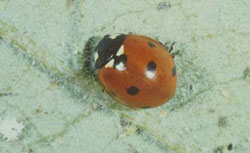
Robert M. McPherson, University of Georgia, Bugwood.org
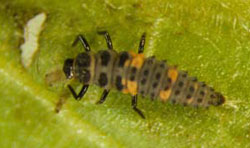
Lenny Wells, University of Georgia, Bugwood.org
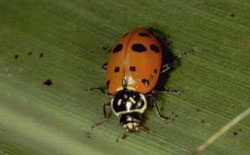
Frank Peairs, Colorado State University, Bugwood.org
[return]
Vertebrate Pests
Birds, moles, raccoons, deer, or other animals may eat or injure agricultural or horticultural crops. The usual management strategy is to keep their numbers to a level where the damage or injury is economically acceptable. Local and state laws may prohibit the killing or trapping of some vertebrate animals without special permits. Before you begin a control program, check with local authorities.
Methods of vertebrate pest control include: mechanical control, baits, sanitation, and exclusion. Few pesticides are available for control of pests other than rodents and most of them require special local use permits. Most are applied as baits. Examples of chemicals used to control vertebrate pests include rodenticides and avicides (birds).
[return]
1) Gradual metamorphosis has ____ developmental stages.
2)Complete metamorphosis has ____ developmental stages.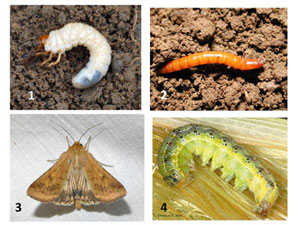
3) Which picture above is a white grub?
4)Which picture above is the larval stage of picture 3?
5) A white grub has ________ mouthparts.
6) Feeding by __________ can deform plant parts or kill developing seeds.
7) Which soil insect chews on plant roots?
8) Which of the following is NOT a sap feeder?
website content by L. Townsend website design by P. Dillon copyright © 2016 University of Kentucky Department of Entomology
University of Kentucky College of Agriculture |
S-225 Agricultural Science Center North, Lexington, KY 40546-0091 | 859.257.7450
An Equal Opportunity University |
Last modified
11/30/2018
